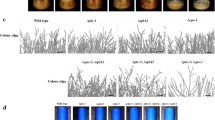Abstract
Approximately 60 developmental mutants ofMyxococcus xanthus M300 were obtained through nitrosoguanidine mutagenesis and placed into three operationally defined categories. Type-I strains exhibited no aggregation or sporulation. Type-II strains were able to aggregate but did not sporulate. A strain classed as a type-III strain was a low-capacity fruiter. Each category displayed defects in cyclic nucleotide behavior that could be predicted from the current model. Most significantly, several aggregationless (type I) mutants lacking cGMP phosphodiesterase aggregated in the presence of externally applied phosphodiesterase. A requirement for cell-cell contact in sporulation has been confirmed. Evidence is presented that suggests the involvement of cAMP phosphodiesterase in sporulation and that sporulation may be a developmental pathway independent of aggregation. These results support a previously published hypothesis of the role of cyclic nucleotides in the development ofM. xanthus.
Similar content being viewed by others
Literature Cited
Brown SS, Rutherford CL (1980) Localization of cyclic nucleotide phosphodiesterase in the multicellular stages ofDictyostelium discoideum. Differentiation 16:173–183
Burchard RP (1975) Myxospore induction in a nondispersed growing mutant ofMyxococcus xanthus. J Bacteriol 122:302–306
Devi AL, McCurdy HD (1984) Cyclic GMP and cyclic AMP binding proteins inMyxococcus xanthus. J Gen Microbiol 130:1845–1849
Devi AL, McCurdy HD (1984) Adenylate cyclase and guanylate cyclase inMyxococcus xanthus. J Gen Microbiol 130:1851–1856
Goren EN, Rosen OM (1972) Purification and properties of a cyclic nucleotide phosphodiesterase from bovine heart. Arch Biochem Biophys 153:384–397
Hagen DC, Bretscher AP, Kaiser D (1978) Synergism between morphogenetic mutants ofMyxococcus xanthus. Dev Biol 64:284–296
Ho J, McCurdy HD (1979) Demonstration of positive chemotaxis to cyclic GMP and 5′-AMP inMyxococcus xanthus by means of a simple apparatus for generating practically stable concentration gradients. Can J Microbiol 25:1214–1218
Ho J, McCurdy HD (1980) Sequential changes in the cyclic nucleotide levels and cyclic nucleotide phosphodiesterase activities during development inMyxococcus xanthus. Curr Microbiol 3:197–202
Ho J, Warner AH, McCurdy HD (1979) Recovery of quenched radioactivity from thin layer chromatographic plates: an improved assay for cyclic GMP phosphodiesterase inMyxococcus xanthus. J Biochem (Tokyo) 88:659–662
Hodgkin J, Kaiser D (1977) Cell to cell stimulation of movement in non-motile mutants ofMyxococcus. Proc Natl Acad Sci USA 74:2938–2942
Lowry OH, Rosebrough NJ, Farr AL, Randall RJ (1951) Protein measurement with the Folin phenol reagent. J Biol Chem 193:265–275
McCurdy HD (1963) A method for the isolation of myxobacteria in pure culture. Can J Microbiol 9:282–285
McCurdy HD (1974) The gliding bacteria. In: Buchanan RE, Gibbons NE (eds) Bergey's manual of determinative bacteriology, 8th edn, Baltimore: Williams and Wilkins, pp 76–98
McCurdy HD, Ho J, Dobson WJ (1978) Cyclic nucleotides, cyclic nucleotide phosphodiesterase and development inMyxococcus xanthus. Can J Microbiol 24:1475–1481
Morrison CE, Zusman DR (1979)Myxococcus xanthus mutants with temperature-sensitive, stage-specific defects: evidence for independent pathways in development. J Bacteriol 140:1036–1042
Orlowski M (1980) Cyclic adenosine 3′, 5′-monophosphate binding protein in developing myxospores ofMyxococcus xanthus. Can J Microbiol 26:905–911
Steiner AL, Parker CW, Kipnis DM (1972) Radioimmunoassay for cyclic nucleotides. I. Preparation of antibodies and iodinated cyclic nucleotides. J Biol Chem 247:1106–1113
Zusman DR (1978) A rapid batch assay for cyclic AMP phosphodiesterase. Anal Biochem 84:551–558
Author information
Authors and Affiliations
Rights and permissions
About this article
Cite this article
Passador, L., McCurdy, H.D. Cyclic nucleotides and development ofMyxococcus xanthus: Analysis of mutants. Current Microbiology 12, 289–294 (1985). https://doi.org/10.1007/BF01567980
Issue Date:
DOI: https://doi.org/10.1007/BF01567980




